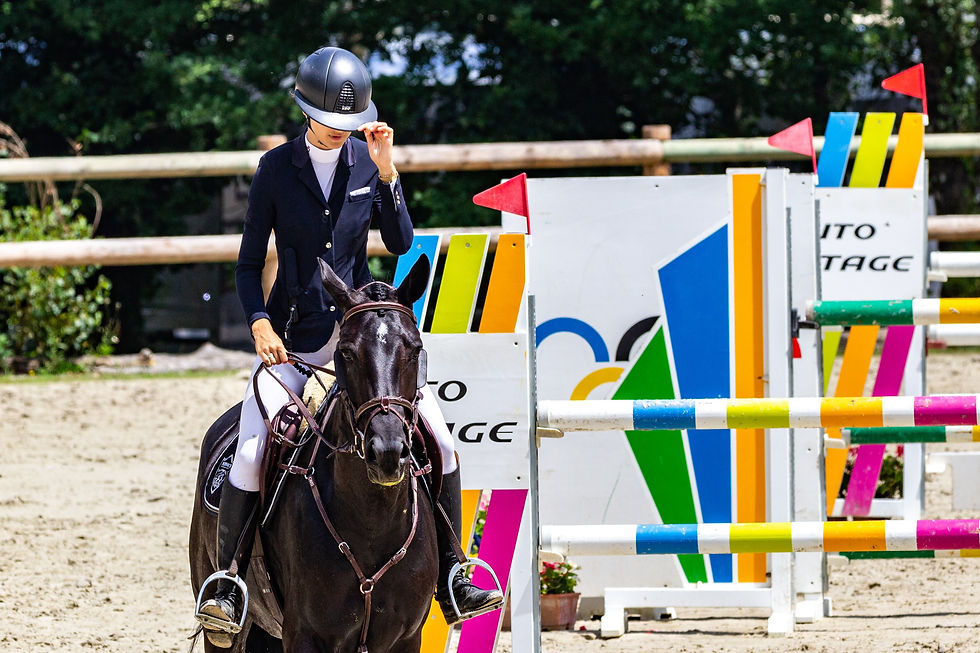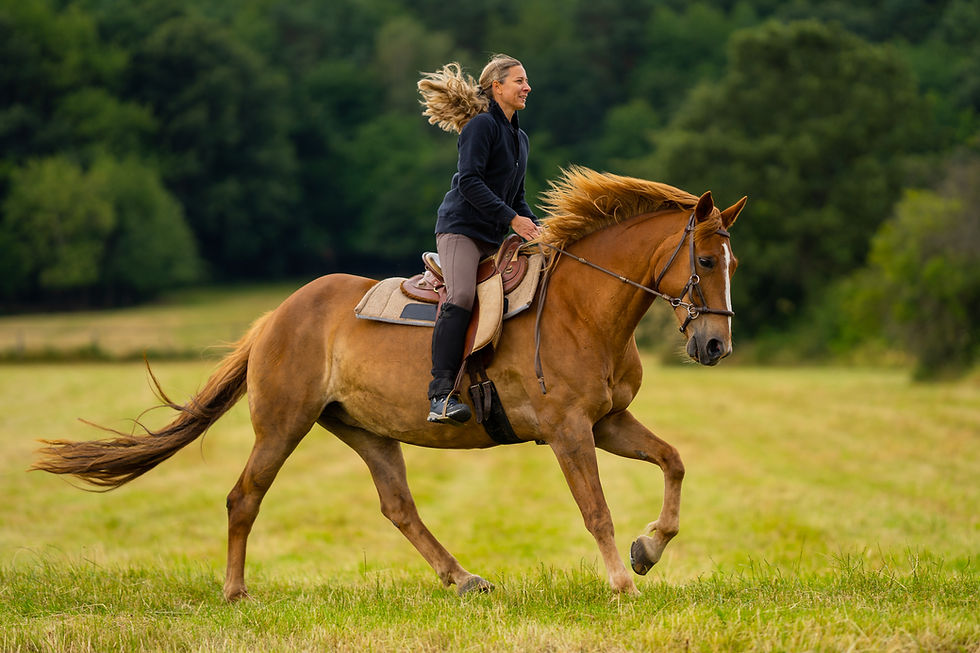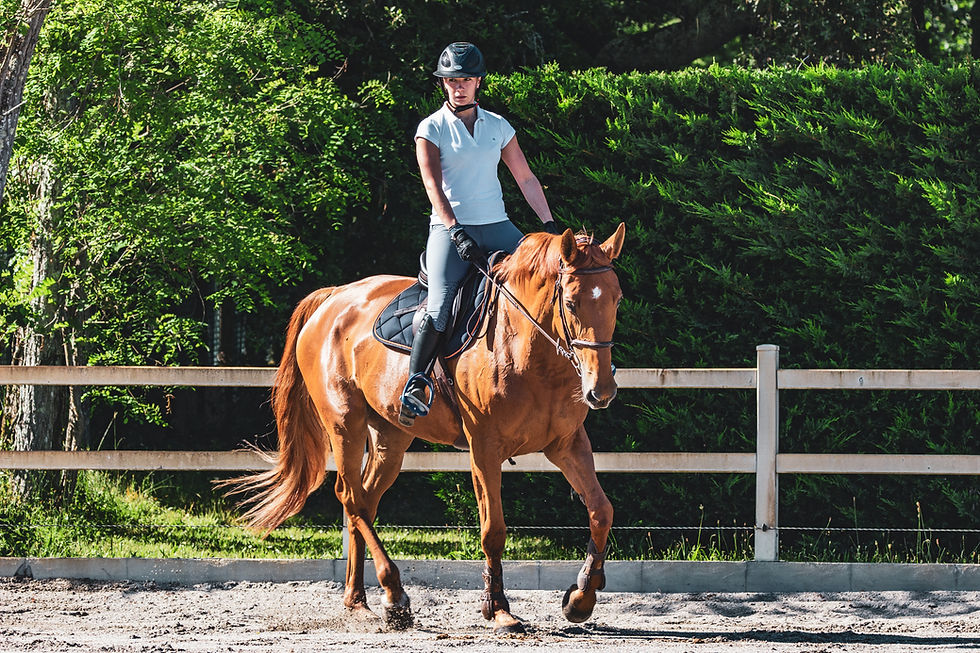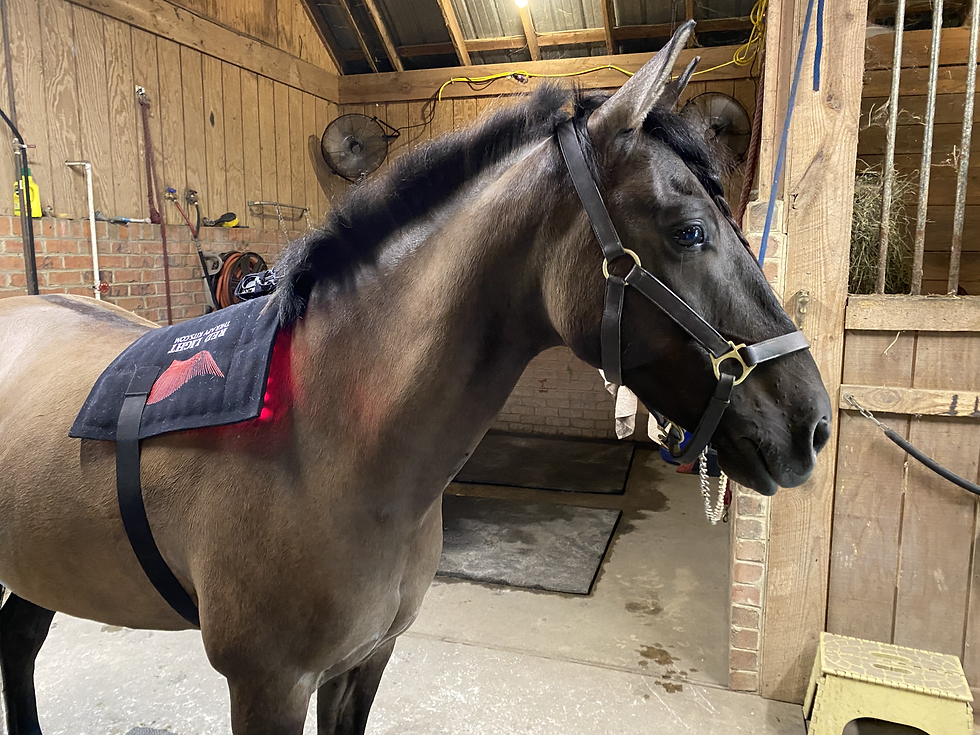Enhancing Recovery After a Horse Show
- stephanie pope
- Jan 6
- 8 min read
Updated: Jan 31

Horse shows are a true test of a horse’s physical abilities and mental endurance. From rigorous warm-ups to high-energy performances, these events demand peak performance, often pushing horses to their limits. Beyond the physical exertion, the mental strain of travel, new environments, and constant activity can take a toll on even the most seasoned competitors.
Proper post-show recovery is essential to ensure your horse remains healthy, resilient, and ready for future events. Skipping or minimizing recovery care can lead to muscle soreness, inflammation, fatigue, and even long-term injuries. By prioritizing recovery, you not only support your horse’s immediate well-being but also enhance their long-term performance and overall quality of life.
Complementary therapies like red light therapy, kinesiology taping, and acupressure offer effective and holistic ways to aid in recovery. Red light therapy promotes muscle repair and reduces inflammation. Kinesiology taping provides physical support and improves circulation to reduce swelling. Acupressure helps restore energy balance and reduces stress. Together, these therapies can create a comprehensive recovery routine to keep your equine partner in top condition.
Red Light Therapy for Muscle Recovery

Red light therapy is a cutting-edge, non-invasive treatment that harnesses specific wavelengths of light to penetrate the skin and stimulate cellular activity. By increasing circulation, red light therapy delivers more oxygen and nutrients to the tissues, which helps repair damage and reduce inflammation. Additionally, this therapy boosts ATP production in cells, providing the energy needed for faster and more effective healing.
Benefits for Post-Show Recovery
Alleviating Muscle Soreness: After intense physical exertion, muscles can become tight and sore. Red light therapy helps relax these muscles and reduce lactic acid buildup, providing relief.
Speeding Up Healing of Minor Injuries: Strains, microtears, and bruises are common after shows. Red light therapy accelerates tissue repair by promoting collagen production and reducing inflammation.
Enhancing Overall Relaxation and Recovery: The soothing effect of red light therapy helps calm your horse’s nervous system, aiding both physical and mental recovery.
Poll Tension Relief: By alleviating poll tension, you can help your horse maintain a more natural and relaxed posture, which is essential for optimal performance and recovery. Addressing tension in the poll not only benefits the physical body but also has a calming effect on the horse, as this area is sensitive and closely linked to the nervous system.
Tips for Using Red Light Therapy After a Show
Concentrate on major muscle groups such as the back, shoulders, glutes, and legs, as well as joints that experience high impact, like the hocks and knees.
Session Duration and Frequency:
Apply red light therapy to each targeted area for 20 minutes, depending on the device and the horse’s needs.
For best results, sessions can be performed daily for the first few days post-show, gradually reducing frequency as the horse recovers. You can apply red light therapy up to 3 times per day for continuous cell boosting benefits.
Practical Considerations: Ensure your horse is relaxed and cooled down before and during the session. Use a portable red light device or a specialized wrap for ease of application.
By integrating red light therapy into your post-show recovery plan, you can effectively reduce discomfort, support healing, and set the stage for your horse to perform their best in future events.
Kinesiology Taping for Inflammation and Support

Kinesiology taping is a versatile recovery tool that involves applying stretchy, adhesive tape to specific areas of the body to support muscles and joints while allowing full range of motion. The tape works by lifting the skin slightly, improving blood flow and lymphatic drainage. This helps reduce swelling, alleviate pain, and provide support to strained or overused muscles, making it an effective choice for post-show recovery.
Benefits for Horses Post-Show
Supporting Strained or Overused Muscles: Horses often experience muscle fatigue and minor strains after competing. Kinesiology tape provides gentle support to these areas, reducing the risk of further strain while promoting recovery.
Reducing Swelling and Inflammation: By improving circulation and lymphatic flow, the tape helps manage swelling in areas that experience high stress, such as legs and joints.
Improving Proprioception for Better Movement During Recovery: The tape provides sensory feedback to the horse’s body, enhancing proprioception (awareness of body positioning). This can improve coordination and prevent compensatory movements that could lead to injuries.

Common Areas for Taping After a Show
Legs: To address swelling and support tendons and ligaments.
Back and Loin: For muscle tension relief and support.
Shoulders and Hips: To provide stability to areas involved in heavy performance demands.
Importance of Correct Application for Effectiveness:
Ensure the horse’s coat is clean and dry before applying the tape to improve adhesion.
Apply with appropriate tension—too tight may restrict movement, while too loose might not provide the desired support.
Seek guidance from a trained professional or take a taping course to learn proper techniques.
Monitor the horse’s reaction to ensure the tape is comfortable and effective.
Kinesiology taping offers a practical and effective way to aid recovery, support healing, and maintain mobility in your horse after a demanding show. With proper application, it can be a valuable addition to your post-show care routine.
Acupressure to Restore Energy Balance

Horse shows place a significant physical and emotional strain on your horse. The intense activity, combined with the stress of travel and exposure to new environments, can disrupt the body’s energy balance. In Traditional Chinese Medicine (TCM), this imbalance can affect the flow of chi (vital energy) through the meridian system, leading to fatigue, tension, and diminished recovery. Acupressure is a natural and effective way to restore this energy balance and support holistic healing after a show.
Role of Acupressure in Recovery
Promoting Relaxation and Reducing Stress: Acupressure helps calm the nervous system, relieving stress and anxiety that can linger after a busy show day. It allows your horse to transition smoothly into a state of rest and recovery.
Boosting Energy Levels by Targeting Specific Points: Stimulating acupressure points encourages a smooth flow of energy, helping to combat fatigue and replenish vitality.
Supporting Organ Systems for a Holistic Recovery Approach: Acupressure can assist in harmonizing the functions of key organ systems, such as the liver, which processes toxins, and the spleen, which is associated with digestion and energy production in TCM.
Key Acupressure Points to Focus on Post-Show
Bai Hui (Hundred Meetings): Located on the sacrum, this point is known for promoting relaxation and boosting energy.
BL-13 (Lung Shu): Supports respiratory health and immune function, particularly after exposure to different environments.
ST-36 (Leg Three Miles): A versatile point that aids in digestion, energy restoration, and overall vitality.
BL-60 (Kunlun): Found near the hock, this point helps alleviate muscle tension and improves circulation in the hindquarters.
Practical Tips for Performing Acupressure
Learning to perform acupressure on your horse is a rewarding way to enhance their health, well-being, and recovery. Our online equine acupressure course provides you with the tools and knowledge to confidently apply this ancient practice, offering practical tips to ensure you get the most out of every session. From understanding the best timing to incorporating effective techniques, this course is designed to guide you step-by-step, so you can support your horse in achieving optimal balance and vitality. Whether you’re addressing specific concerns or simply aiming to keep your equine partner feeling their best, this course empowers you to make a positive impact on their overall care.
Timing and Technique:
Perform acupressure in a calm and quiet environment where your horse feels safe.
Use gentle yet firm pressure, holding each point for about 30–60 seconds.
Observe your horse’s response—signs of relaxation like licking, chewing, or lowering the head indicate effectiveness.
Incorporating Acupressure into Your Horse’s Routine:
Include acupressure sessions within a few hours after a show to support recovery.
Make it a regular part of your horse’s care plan to address chronic stress and enhance overall well-being.
Acupressure offers a powerful, hands-on method to restore your horse’s energy balance, reduce stress, and promote full-body recovery. By incorporating this ancient technique into your post-show routine, you can help your equine partner feel their best and perform at their peak.
Combining Therapies for Optimal Recovery

Integrating various recovery modalities such as cryotherapy, chiropractic adjustments, massage therapy, and Pulsed Electromagnetic Field Therapy (PEMF) can offer a comprehensive approach to your horse's post-show care. Each therapy targets different aspects of recovery, and when combined, they can significantly enhance your horse's overall well-being and readiness for future events.
Cryotherapy: Cryotherapy, or the application of cold therapy, is an excellent option for addressing acute inflammation, swelling, and soreness. By cooling targeted areas, cryotherapy constricts blood vessels, reduces inflammation, and temporarily numbs pain, offering immediate relief after intense activity. It’s especially useful for legs, which often bear the brunt of show-related stress.
Chiropractic: These focus on correcting misalignments in the spine and joints that can occur during intense physical activity at shows. Chiropractic care improves mobility, reduces pain, and enhances nervous system function by ensuring proper alignment. Regular adjustments help prevent injuries and optimize performance by maintaining the horse's structural balance.
Massage Therapy: Massage aids in relieving muscle tension, reducing stress, and improving circulation. After a show, your horse's muscles may be tight or sore from exertion. Massage therapy helps release lactic acid buildup, promotes relaxation, and accelerates muscle recovery. It also provides an opportunity to detect any areas of discomfort that may require additional attention.
Pulsed Electromagnetic Field Therapy (PEMF): PEMF uses electromagnetic fields to stimulate cellular function and promote healing. It enhances circulation, reduces inflammation, and can alleviate pain in both superficial and deep tissues. PEMF is beneficial for addressing muscle fatigue, joint stiffness, and accelerating the healing of minor injuries.
The Role of Veterinary Care in Recovery

While complementary therapies such as red light therapy, acupressure, massage, and cryotherapy are powerful tools for recovery, they should always work in conjunction with proper veterinary care. A trusted veterinarian is the cornerstone of your horse’s health and well-being, especially after the physical and emotional demands of a show.
Veterinary care ensures that any underlying issues—such as injuries, infections, or systemic concerns—are accurately diagnosed and treated. Regular check-ups and post-show evaluations can identify subtle signs of strain or discomfort that might otherwise go unnoticed, preventing minor issues from becoming serious problems.
Complementary therapies are most effective when applied within the context of a veterinarian-approved recovery plan. For example:
Addressing Acute Concerns: Your veterinarian can assess areas of swelling, lameness, or unusual behavior, providing a clinical diagnosis and guiding the use of therapies like cryotherapy or PEMF.
Collaborating for Optimal Results: A vet can recommend the best timing for incorporating chiropractic adjustments or massage to avoid exacerbating injuries or discomfort.
Ensuring Safety and Efficacy: Veterinary oversight ensures that all treatments, including complementary ones, are safe for your horse’s specific condition and history.
By working hand-in-hand with your veterinarian, you can create a recovery plan that combines the precision of medical care with the restorative power of complementary therapies, ensuring your horse returns to full health and peak performance.

Customizing Recovery Plans Based on Individual Horse Needs
Assess Specific Needs: Every horse is unique in terms of physical condition, workload, and areas of stress. Tailor the recovery plan to address your horse's specific challenges and performance demands.
Consult Qualified Professionals: Work with experienced practitioners who specialize in equine care to ensure each therapy is applied safely and effectively.
Monitor and Adjust: Keep track of your horse's responses to each modality. Adjust the frequency and combination of therapies as needed to maximize recovery benefits.
By focusing on these therapies, you create a multifaceted recovery strategy that addresses muscle health, joint function, and cellular repair. This holistic approach not only facilitates immediate recovery after a show but also contributes to your horse's long-term health and sustained ability to perform at their best.
Holistic Recovery for Peak Equine Performance
After a horse show, prioritizing your horse’s recovery is essential for their health, comfort, and long-term performance. By integrating complementary therapies such as acupressure, red light therapy, kinesiology taping, chiropractic, massage, PEMF, and cryotherapy, alongside proper veterinary care, you can address both physical and emotional demands. These therapies not only enhance recovery but also prevent future injuries and promote overall well-being.
Creating a tailored recovery plan that considers your horse’s unique needs ensures they are ready to perform their best at the next event. Whether you’re focusing on relieving muscle tension, reducing inflammation, or restoring energy balance, a thoughtful approach to recovery makes all the difference.
Invest in your horse’s health by combining science-backed veterinary care with holistic, complementary therapies. Your dedication to their well-being ensures they stay strong, happy, and prepared for every challenge.




